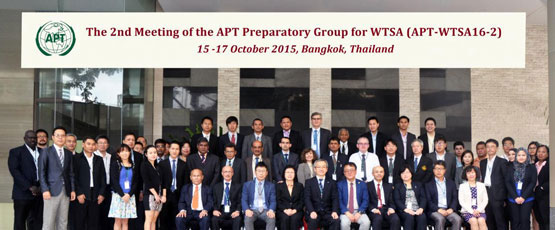
The World Telecommunications Standardization Assembly in 2012 is still a recent memory for those who participated, but the preparations for the next iteration of this four-yearly event by the International Telecommunications Union (ITU) have already begun with some regions already holding their first meetings and the Asia Pacific already on to its second.
APNIC did not participate in the first meeting as it conflicted with APRICOT 2015 in Fukuoka, Japan and APNIC 39. That first meeting had little real content. It consisted mainly of procedures to set the Terms of Reference, decide a work schedule, and election of Chairs and Vice-Chairs of the Plenary and three Working Groups that were established to develop and agree on Asia Pacific Common Proposals to be submitted to the WTSA event, which is still around one year away.
The second of four preparatory meetings, staged by the Asia Pacific Telecommunity (WTSA16-2) was held from 15 to 17 October 2015 in Bangkok, Thailand.
APNIC is a member of both the APT and the Development sector of the ITU and although the WTSA is a T-sector (Telecommunications-sector) conference other RIRs including ARIN and the RIPE NCC are members of the T-sector.

2nd Meeting of the APT-WTSA16-2, Bangkok Thailand
Both organizations have responded well to calls from non-government entities for permission to participate in the activities and determinations developed at these meetings with both the APT and ITU meetings in this round open to contributions from affiliate and sector members respectively.
At this time, APNIC has no plans to make individual submissions to the APT preparatory process and participated in the second preparatory meeting to better understand the issues likely to be addressed in the process. Certainly if members of the Asia Pacific addressing community identify issues which it feels necessary to address, the APNIC Secretariat is well-placed to submit information documents or contributions as appropriate.
Topics of interest in AP region
Although the subjects under discussion in the APT WTSA16 process will likely evolve as other regions reveal their own agendas, the following areas of discussion have already been raised as likely topics of interest to the region.
- As the WTSA is convened only once every four years, there is sometimes a need to respond to changing conditions by altering study areas in the interim. The Republic of Korea proposed to the second preparatory meeting that the powers of the ITU TSAG (Telecommunication Standardization Advisory Group) could be reviewed to ensure they are adequate and appropriate. The TSAG recently used these powers to establish a new study group on the Internet of Things and Smart Cities, which is seen as a key area of importance for the ITU.
- Japan proposed the elaboration of a “Standardization Landscape” to better conceptualise and organize the work of the Union. Standards development in the current ITU structure can sometimes seem disjointed and has overlaps between Study Groups, by developing a higher-level view of the current and future working plans the Union could deliver more effective results.
- Vietnam proposed that the preparatory group should consider common proposals addressing a number of key areas it sees as a concern. These are: Bridging the Standardization Gap, Green ICT and EMF issues, Conformance and Interoperability, Internet of Things/Machine-to-Machine, QoS & QoE. All these are current ITU activities, but the WTSA offers an opportunity to review and refine these activities for the next study period beginning in 2017.
- Finally, the APT Preparatory group’s Chair, proposed a survey to be sent to all APT Members asking for input on each of the 50 or so Resolutions that fall under the control of the WTSA. The WTSA is not a treaty level conference, but these documents can place responsibilities and requirements on Member States. The survey asks for Interest, and Comments as open text against a full list of the Resolutions.
Internal issues – To Do
In addition to the areas of interest highlighted by individual governments, there are a number of initiatives proposed and emanating from internal ITU groups and review activities.
The ITU-T RevCom is a Review Committee which reports to the TSAG, it has identified some efficiencies that could be gained by reviewing and streamlining the ITU Study Group structure. In addition to the 11 Study Group which work on developing standards documents there are a number of associated activities including Focus Groups, Joint Coordination Activities, Global Standards Initiatives and so on. It is acknowledged that this infrastructure could do with some review and streamlining.
Even the number of Study Groups is in many ways an encumbrance and with a large number of Study Group Chairs reaching the end of their term limits, the WTSA16 is being seen as an opportunity to reduce the number of groups without causing offense to sitting Chairs.
Finally, another source of inputs are the annual CTO Meetings convened by the ITU Secretariat, the most recent of these, held in conjunction with ITU Telecom World, delivered a communiqué which highlighted the following topics as of importance to the inter-governmental standards process.
Briefly, 5G systems, service interoperability in fixed-mobile hybrid environments including the Internet of Things, trusted information infrastructure, and open-source solutions were key topics in the discussions and were identified as areas of particular strategic importance to the participants.
Going forward
The third and fourth meeting in the APT preparatory process for WTSA16 will be convened in June and August next year ahead of the world conference which is unscheduled, but must be staged in the fourth quarter 2016.
APNIC will continue to monitor progress, contributions, and activities in our own and other regions providing analysis, information, and assistance to the process as appropriate.
The views expressed by the authors of this blog are their own and do not necessarily reflect the views of APNIC. Please note a Code of Conduct applies to this blog.
